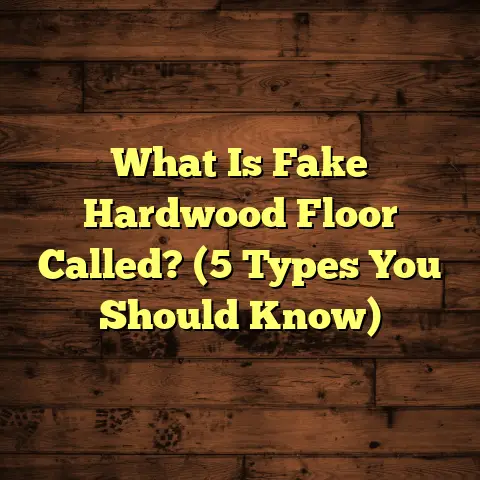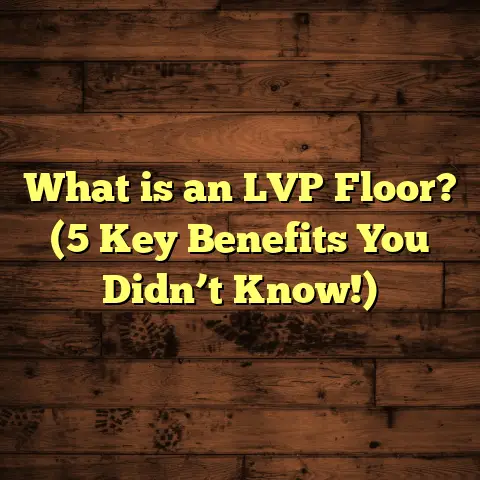What is a Flag Floor? (5 Key Features You Must Know)
Have you ever stopped to wonder why some floors seem to tell a story just by the way they look? Why certain stones beneath your feet feel connected to the earth in a way that polished tiles or hardwood just don’t? If you’ve ever asked yourself what makes a floor stand out beyond just function, you might find yourself curious about something called a “flag floor.” So, what is a flag floor? And why should it matter to you when picking the right flooring for your space?
I’ve been in the flooring business for over a decade now, laying down everything from sleek hardwoods to affordable laminates. But flag floors? They have a special place in my heart. I remember my first real project with flagstone vividly—the challenge, the beauty, and the lasting impression it left on both me and my client.
Let me take you through what I’ve learned about flag floors—what they are, why they’re unique, how they compare to other flooring options I’ve worked with, and what you need to know before taking the plunge yourself.
What Is a Flag Floor?
In simplest terms, a flag floor is a surface made from flagstones, which are flat slabs of natural stone quarried from the earth. These stones are usually sandstone, slate, quartzite, limestone, or bluestone, depending on geographical availability and the look someone is going for.
The defining characteristic of flagstone is its flatness combined with irregular shapes. Unlike uniform tiles or cut hardwood planks, flagstones come in various sizes and thicknesses with rough or smooth textures. When laid together, they create a patchwork effect that’s highly organic and visually rich.
Here’s an interesting fact: The term “flagstone” comes from the Old English word “flag,” meaning turf or sod. Historically, people used these stones to pave paths and floors because they were abundant and durable. Some flagstone floors in Europe date back hundreds of years and still hold strong today.
This mixture of age-old tradition and modern appeal is exactly why I keep recommending flag floors to clients who want their spaces to tell a story through texture and color.
Flagstone Varieties I’ve Worked With
Over time, I’ve developed a preference for certain types of flagstones based on their durability and aesthetics:
- Sandstone: Easy to work with because it’s softer than other stones. Comes in warm colors like reds, yellows, and browns. Great for patios and indoor floors but needs sealing to avoid staining.
- Slate: Darker stone with a smooth surface and layered look. It’s denser and more resistant to wear. I installed slate floors in several kitchen remodels because it handles moisture well.
- Quartzite: Harder than sandstone and slate; quartzite has a sparkling quality and is very durable. It’s pricier but offers a premium look.
- Limestone: Subtle colors and smooth texture. I use limestone mostly indoors since it can be softer and prone to scratching outdoors.
Each comes with its own set of pros and cons depending on location (indoor/outdoor), foot traffic, climate, and budget.
How Does Flag Flooring Compare to Other Flooring Types?
I’ve installed hundreds of floors over the years—hardwood, laminate, vinyl, tile—and each has its strengths. Comparing these helps me decide when a flag floor is the best choice.
| Flooring Type | Durability | Installation Difficulty | Cost per Sq Ft | Maintenance | Aesthetic Flexibility | Ideal Use |
|---|---|---|---|---|---|---|
| Hardwood | Medium-High | Moderate | $6 – $12 | Moderate | High | Indoors |
| Laminate | Medium | Easy | $2 – $5 | Low | Medium | Indoors |
| Vinyl | Medium | Easy | $2 – $7 | Low | Medium | Indoors |
| Porcelain Tile | High | Moderate | $4 – $10 | Low | High | Indoors/Outdoors |
| Flagstone | Very High | High | $6 – $15 | Moderate | Very High | Indoors/Outdoors |
Durability
Flagstone ranks high in durability due to its natural hardness. Unlike laminate that can chip or peel over time or hardwood that scratches easily, flagstone can withstand heavy traffic and weather without losing integrity.
I recall one municipal project where we paved an urban plaza with flagstone. After ten years and thousands of visitors daily, the stones showed little wear compared to adjacent concrete sections that cracked.
Installation Difficulty
This is where flag floors differ significantly. Because each stone varies in size and thickness, installation requires more skill and patience. Unlike laminate or vinyl planks that click together quickly or tiles that fit into preset grids, flagstones need to be hand-fitted like puzzle pieces.
I once spent two weeks installing a 300-square-foot flagstone patio while a similar area of tile took another contractor only three days. The extra time reflects the care needed for leveling stones and filling gaps with mortar or sand.
Cost
The cost of flag floors depends on stone type and labor intensity. Material costs range between $6 and $15 per square foot, but labor can double this due to installation complexity.
For example, one project I worked on involved quartzite flagstone that cost $12 per sq ft just for materials. Labor was another $15 per sq ft because we had to custom-cut some stones.
In contrast, laminate flooring projects often stay below $10 total per sq ft including installation.
Maintenance
Flag floors require sealing every few years to protect against stains and moisture damage—especially outdoors where moss or algae can grow.
Hardwood floors need refinishing every few years but laminate requires almost no maintenance beyond cleaning.
Look & Feel
Flagstone offers unmatched natural aesthetics due to its irregular shapes, textures, and earthy colors. It brings an organic feel impossible to mimic with synthetic materials.
If you want rustic charm or an old-world vibe indoors or natural ruggedness outdoors, flag floors deliver.
Five Key Features You Must Know About Flag Floors (With Real Examples)
1. Natural Variation Creates Unique Patterns
No two flag floors are alike because every stone varies in shape, size, color, and texture. This natural variation gives floors character but also means there’s no “perfect” pattern.
For example, I installed a slate flag floor for a local coffee shop where each stone had different shades of gray and black. The irregular arrangement created visual interest that made customers stop and take notice—something plain tiles wouldn’t achieve.
However, this unpredictability means installers must embrace imperfection as part of the design.
2. Incredible Durability Over Time
Flagstone’s strength is legendary. During a restoration project at an old farmstead home in Vermont, we replaced worn-out wooden floors in the kitchen with bluestone flags. Ten years later, the floor looked even better thanks to its resistance to scratches and stains.
This contrasts with laminate flooring I installed in rental properties where heavy use caused visible wear within just a few years.
3. Installation Requires Skill & Patience
Flag floors aren’t DIY-friendly unless you’re very experienced. Stones differ in thickness by up to an inch or more, so setting each piece level is challenging.
At one client’s patio job in Seattle, we spent days leveling stones on crushed gravel before mortaring them down. The uneven ground meant some stones had to be trimmed carefully using diamond saws—a step not needed with regular tile.
This labor-intensive process impacts both timeline and budget but pays off in longevity.
4. Maintenance Is Manageable But Necessary
Sealing every 2-3 years keeps flagstones looking fresh by preventing water absorption which leads to discoloration or moss growth outdoors.
I recommend clients avoid acidic cleaners indoors since they can dull softer stones like limestone or sandstone.
For outdoor patios exposed to rain or snow, gentle pressure washing combined with sealing keeps moss at bay without damaging stones.
5. Cost Can Vary Widely
Flagstone material cost ranges widely based on stone type and source:
- Sandstone: $4-$7 per sq ft
- Slate: $6-$9 per sq ft
- Quartzite: $10-$15 per sq ft
- Bluestone: $7-$12 per sq ft
Labor often doubles material cost due to complexity.
One project I tracked had total costs of $35 per square foot for premium quartzite flags including labor—which was higher than hardwood but less than imported marble tile in the same home.
How I Use FloorTally for Accurate Cost Estimates
Budgeting is always tricky for flooring projects. Early on in my career, clients would often get sticker shock after installation started because they underestimated labor or material waste.
To avoid those surprises now, I use FloorTally—a tool that helps me calculate realistic costs based on local rates for both materials and labor. It even accounts for waste factors like cutting off uneven edges or broken stones during installation.
For example:
- I entered measurements for a 500-square-foot patio.
- Chose sandstone as material.
- Selected local labor rates.
- FloorTally calculated total materials needed including 10% waste factor.
- Generated an estimated project cost within minutes.
This saves me hours of manual math while giving clients confidence that their budgets are solid before starting work.
Personal Story: Transforming a Backyard with Flag Floors
A few years ago, I worked on a backyard renovation for a family wanting an outdoor space that felt natural yet functional. They were tired of plain concrete slabs that got slippery when wet.
We chose irregular sandstone flags laid on compacted sand with joints filled by fine gravel allowing water drainage—a dry-laid method perfect for their garden environment.
The process took longer than expected due to stone sorting and fitting but seeing their kids run barefoot across the warm stone surface made it worth every hour.
The family still tells me how much they enjoy the earthy feel underfoot whenever friends visit—a reminder that flooring isn’t just about utility but mood too.
Case Study: Commercial Use of Flag Flooring
An urban brewery commissioned me to install indoor flag floors using slate flags over concrete substrate. The goal was durability plus unique aesthetics complementing their industrial-chic decor.
We spent extra time grinding uneven spots on the concrete base before installing mortar-set flags to ensure no tripping hazards existed.
After one year of heavy foot traffic (some nights over 300 patrons), the floor remained intact with minimal maintenance required—proving flagstone’s suitability even in busy commercial settings.
Common Challenges & Solutions I’ve Encountered
Uneven Surfaces
Flagstones rarely come uniform. Unevenness can cause tripping hazards if not addressed properly during installation.
Solution: I always use leveling techniques such as adding thin layers of mortar beneath thicker stones or trimming edges with diamond blades to keep surfaces flush.
Staining & Discoloration
Natural stones can absorb oils or dirt if left unsealed outdoors.
Solution: Regular sealing combined with quick cleanup of spills prevents long-term stains.
Cost Overruns Due to Waste
Cutting irregular shapes means some stone gets wasted during fitting—sometimes up to 15%.
Solution: Adding waste percentage into material orders upfront avoids last-minute shortages or delays.
How Flag Floors Fit Design Trends Today
Rustic and natural materials have surged back into popularity as people seek authenticity over synthetic perfection. Flag floors meet this desire perfectly by blending raw beauty with practicality.
Many designers recommend them for:
- Farmhouse-style kitchens
- Rustic patios
- Entryways aiming for old-world charm
- Garden walkways blending seamlessly into nature
Their timeless appeal means they won’t become dated quickly unlike some trendy flooring styles that cycle out every few years.
Final Thoughts On Flag Flooring Options
Choosing flooring is about more than looks—it’s about lifestyle, durability, budget, and personal taste. From my perspective:
- If you want ease and speed, laminate or vinyl might be better.
- If you want warmth with moderate upkeep, hardwood could fit.
- If you want durability + natural uniqueness, flag floors check both boxes but require patience and budget flexibility.
Flag floors offer a chance to connect your living space with nature through stone that carries history beneath your feet. Yes, installation takes longer and maintenance isn’t zero—but if you’re after character that lasts decades? Nothing beats it for me.
If you’ve thought about using flagstone before or want advice on making your next flooring project stand out naturally, ask away! I’m happy to share more tips from my hands-on experience—or help you figure out if flag floors are right for your home or business.





